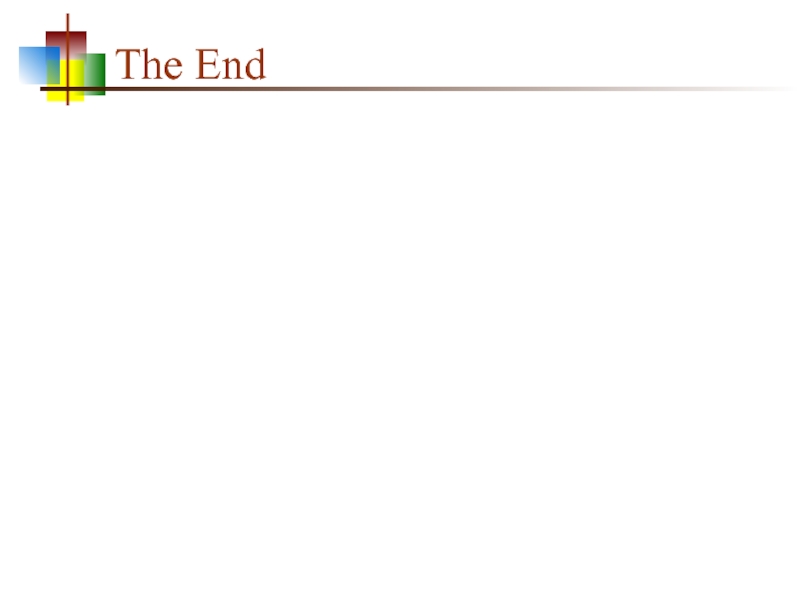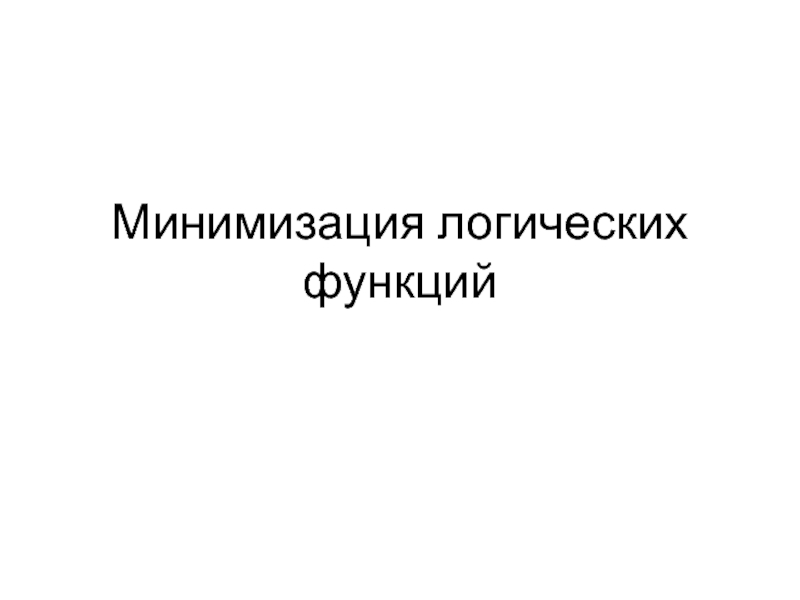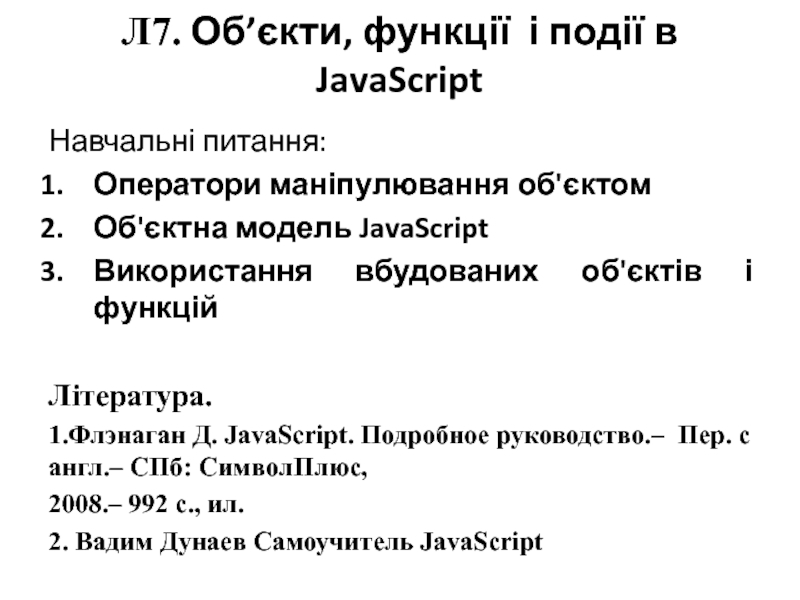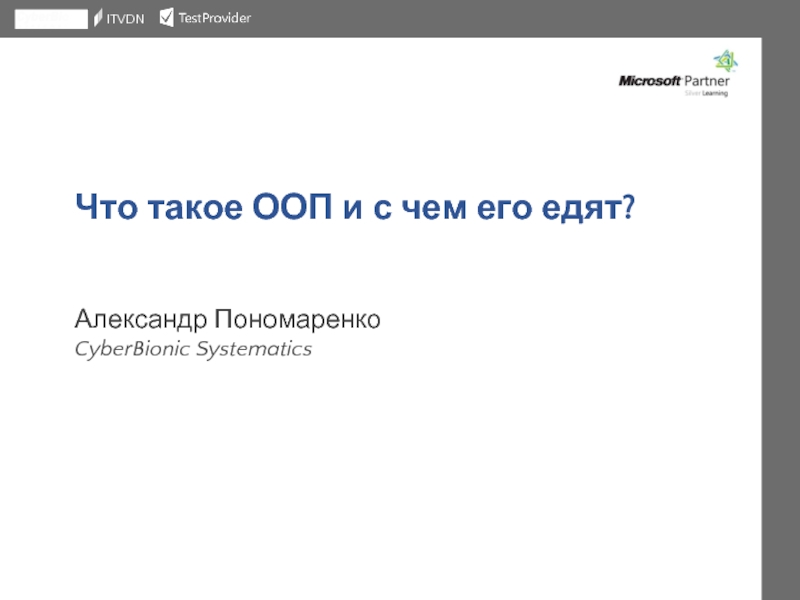- Главная
- Разное
- Дизайн
- Бизнес и предпринимательство
- Аналитика
- Образование
- Развлечения
- Красота и здоровье
- Финансы
- Государство
- Путешествия
- Спорт
- Недвижимость
- Армия
- Графика
- Культурология
- Еда и кулинария
- Лингвистика
- Английский язык
- Астрономия
- Алгебра
- Биология
- География
- Детские презентации
- Информатика
- История
- Литература
- Маркетинг
- Математика
- Медицина
- Менеджмент
- Музыка
- МХК
- Немецкий язык
- ОБЖ
- Обществознание
- Окружающий мир
- Педагогика
- Русский язык
- Технология
- Физика
- Философия
- Химия
- Шаблоны, картинки для презентаций
- Экология
- Экономика
- Юриспруденция
Scala. Lists презентация
Содержание
- 1. Scala. Lists
- 2. Arrays and Lists Arrays are a fixed
- 3. Lists are immutable Lists, like Strings, are
- 4. List operations Basic fast (constant time) operations
- 5. Stepping through a list def printList1(myList: List[Any]) { for (i
- 6. List construction with :: and Nil Lists
- 7. Basic recursion Recursion is when a method
- 8. Again, with pattern matching Here’s our same
- 9. map map applies a one-parameter function to
- 10. flatMap flatten “flattens” a list (removes one
- 11. filter filter is used to remove unwanted
- 12. foldl, foldr The “fold” functions apply a
- 13. for Scala’s for comprehension can be used like Java’s for loop scala> for (ch
- 14. Another for example You need to start
- 15. for-yield The value of a for comprehension,
- 16. Another for-yield example Here’s a more complete
- 17. toList scala> Array(1, 2, 3, 4) toList
- 18. Pattern matching Given this definition: scala> val
- 19. Example program object EnglishToGerman {
- 20. The End
Слайд 2Arrays and Lists
Arrays are a fixed length and occupy sequential locations
in memory
This makes random access (for example, getting the 37th element) very fast--O(1)
Lists are composed of values linked together
All access starts from the head (first element) and follows links
Random access takes linear time
This makes random access (for example, getting the 37th element) very fast--O(1)
Lists are composed of values linked together
All access starts from the head (first element) and follows links
Random access takes linear time
Слайд 3Lists are immutable
Lists, like Strings, are immutable
Because all access is via
the head, creating a “new” list is a fast operation
• myLongerList looks like List("p", "a", "r", "t"); the "p" is not visible from myList
• myShorterList looks like List("r", "t")
• myList has not been changed--it is immutable
Слайд 4List operations
Basic fast (constant time) operations
list.head (or list head) returns the
first element in the list
list.tail (or list tail) returns a list with the first element removed
value :: list returns a list with value appended to the front
list.isEmpty (or list isEmpty ) tests whether the list is empty
Some slow (linear time) operations
list(i) returns the ith element (starting from 0) of the list
list.last (or list last) returns the last element in the list
list.init (or list init) returns a list with the last element removed
This involves making a complete copy of the list
list.length (or list length) returns the number of elements in the list
list.reverse (or list reverse) returns a new list with the elements in reverse order
In practice, the slow operations are hardly ever needed
list.tail (or list tail) returns a list with the first element removed
value :: list returns a list with value appended to the front
list.isEmpty (or list isEmpty ) tests whether the list is empty
Some slow (linear time) operations
list(i) returns the ith element (starting from 0) of the list
list.last (or list last) returns the last element in the list
list.init (or list init) returns a list with the last element removed
This involves making a complete copy of the list
list.length (or list length) returns the number of elements in the list
list.reverse (or list reverse) returns a new list with the elements in reverse order
In practice, the slow operations are hardly ever needed
Слайд 5Stepping through a list
def printList1(myList: List[Any]) {
for (i
0 until myList.length) {
println(myList(i))
}
}
What is the time complexity of this method?
def printList2(myList: List[Any]) { if(! myList.isEmpty) { // the dot is required here println(myList head) printList2(myList tail) } }
What is the time complexity of this method?
What is the time complexity of this method?
def printList2(myList: List[Any]) { if(! myList.isEmpty) { // the dot is required here println(myList head) printList2(myList tail) } }
What is the time complexity of this method?
Слайд 6List construction with :: and Nil
Lists are homogeneous: All elements have
the same type
However, scala> "abc" :: List(1, 2, 3) res15: List[Any] = List(abc, 1, 2, 3)
The newly-created list has a type which is the least upper bound
An empty list has “nothing” in it
scala> List() res16: List[Nothing] = List()
The “name” of the empty list is Nil
scala> Nil res17: scala.collection.immutable.Nil.type = List()
Lists are built from Nil and the :: operator (which is right-associative)
scala> 1 :: 2 :: 3 :: Nil res18: List[Int] = List(1, 2, 3)
scala> 1 :: (2 :: (3 :: Nil)) res19: List[Int] = List(1, 2, 3)
However, scala> "abc" :: List(1, 2, 3) res15: List[Any] = List(abc, 1, 2, 3)
The newly-created list has a type which is the least upper bound
An empty list has “nothing” in it
scala> List() res16: List[Nothing] = List()
The “name” of the empty list is Nil
scala> Nil res17: scala.collection.immutable.Nil.type = List()
Lists are built from Nil and the :: operator (which is right-associative)
scala> 1 :: 2 :: 3 :: Nil res18: List[Int] = List(1, 2, 3)
scala> 1 :: (2 :: (3 :: Nil)) res19: List[Int] = List(1, 2, 3)
Слайд 7Basic recursion
Recursion is when a method calls itself
Here’s the basic formula
for working with a list:
if the list is empty return some initial value (often an empty list) else process the head recur with the tail
def printList2(myList: List[Any]) { if(! myList.isEmpty) { println(myList head) printList2(myList tail) } }
if the list is empty return some initial value (often an empty list) else process the head recur with the tail
def printList2(myList: List[Any]) { if(! myList.isEmpty) { println(myList head) printList2(myList tail) } }
Слайд 8Again, with pattern matching
Here’s our same method again:
def printList2(myList: List[Any]) {
if(! myList.isEmpty) {
println(myList head)
printList2(myList tail)
}
}
Here it is with pattern matching:
def printList3(myList: List[Any]) { myList match { case h :: t => println(myList head) printList3(myList tail) case _ => } }
Here it is with pattern matching:
def printList3(myList: List[Any]) { myList match { case h :: t => println(myList head) printList3(myList tail) case _ => } }
Слайд 9map
map applies a one-parameter function to every element of a List,
returning a new List
scala> List(1, 2, 3, 4) map (n => 10 * n) res0: List[Int] = List(10, 20, 30, 40)
The result list doesn’t have to be of the same type
scala> List(1, 2, 3, 4) map (n => n % 2 == 0) res1: List[Boolean] = List(false, true, false, true)
Since an element of the list is the only parameter to the function, and it’s only used once, you can abbreviate the function
scala> List(1, 2, 3, 4) map (10 * _ + 6) res2: List[Int] = List(16, 26, 36, 46)
Of course, you don’t have to use a literal function; you can use any previously defined function (yours or Scala’s)
scala> List(-1, 2, -3, 4) map (_ abs) res3: List[Int] = List(1, 2, 3, 4)
scala> List(1, 2, 3, 4) map (n => 10 * n) res0: List[Int] = List(10, 20, 30, 40)
The result list doesn’t have to be of the same type
scala> List(1, 2, 3, 4) map (n => n % 2 == 0) res1: List[Boolean] = List(false, true, false, true)
Since an element of the list is the only parameter to the function, and it’s only used once, you can abbreviate the function
scala> List(1, 2, 3, 4) map (10 * _ + 6) res2: List[Int] = List(16, 26, 36, 46)
Of course, you don’t have to use a literal function; you can use any previously defined function (yours or Scala’s)
scala> List(-1, 2, -3, 4) map (_ abs) res3: List[Int] = List(1, 2, 3, 4)
Слайд 10flatMap
flatten “flattens” a list (removes one level of nesting)
scala> val nested
= List(List(1, 2, 3), List(4, 5))
nested: List[List[Int]] = List(List(1, 2, 3), List(4, 5))
scala> nested flatten res0: List[Int] = List(1, 2, 3, 4, 5)
flatMap is like map, but the function given to flatMap is expected to return a list of values; the resultant list of lists is then “flattened”
Syntax:
def map[B](f: (A) => B): List[B]
def flatMap[B](f: (A) => Traversable[B]): List[B]
Example:
scala> val greeting = List("Hello".toList, "from".toList, "Scala".toList) greeting: List[List[Char]] = List(List(H, e, l, l, o), List(f, r, o, m), List(S, c, a, l, a))
scala> greeting map (word => word.toList) res2: List[List[Char]] = List(List(H, e, l, l, o), List(f, r, o, m), List(S, c, a, l, a)) scala> greeting flatMap (word => word.toList)
res3: List[Char] = List(H, e, l, l, o, f, r, o, m, S, c, a, l, a)
scala> nested flatten res0: List[Int] = List(1, 2, 3, 4, 5)
flatMap is like map, but the function given to flatMap is expected to return a list of values; the resultant list of lists is then “flattened”
Syntax:
def map[B](f: (A) => B): List[B]
def flatMap[B](f: (A) => Traversable[B]): List[B]
Example:
scala> val greeting = List("Hello".toList, "from".toList, "Scala".toList) greeting: List[List[Char]] = List(List(H, e, l, l, o), List(f, r, o, m), List(S, c, a, l, a))
scala> greeting map (word => word.toList) res2: List[List[Char]] = List(List(H, e, l, l, o), List(f, r, o, m), List(S, c, a, l, a)) scala> greeting flatMap (word => word.toList)
res3: List[Char] = List(H, e, l, l, o, f, r, o, m, S, c, a, l, a)
Слайд 11filter
filter is used to remove unwanted elements from a list, returning
a new list
scala> List(1, -2, 3, -4) filter (_ > 0) res3: List[Int] = List(1, 3)
There is a corresponding (less often used) filterNot method
scala> List(1, -2, 3, -4) filterNot (_ > 0) res4: List[Int] = List(-2, -4)
scala> List(1, -2, 3, -4) filter (_ > 0) res3: List[Int] = List(1, 3)
There is a corresponding (less often used) filterNot method
scala> List(1, -2, 3, -4) filterNot (_ > 0) res4: List[Int] = List(-2, -4)
Слайд 12foldl, foldr
The “fold” functions apply a binary operator to the values
in a list, pairwise, starting from the left or starting from the right
scala> val list = List(10, 1, 2, 3) list: List[Int] = List(10, 1, 2, 3)
scala> list.foldLeft(0)(_ - _) res3: Int = -16
scala> list.foldRight(0)(_ - _) res4: Int = 8
scala> ((((0 - 10) - 1) - 2) - 3) res6: Int = -16
scala> (10 - (1 - (2 - (3 - 0)))) res8: Int = 8
scala> val list = List(10, 1, 2, 3) list: List[Int] = List(10, 1, 2, 3)
scala> list.foldLeft(0)(_ - _) res3: Int = -16
scala> list.foldRight(0)(_ - _) res4: Int = 8
scala> ((((0 - 10) - 1) - 2) - 3) res6: Int = -16
scala> (10 - (1 - (2 - (3 - 0)))) res8: Int = 8
Слайд 13for
Scala’s for comprehension can be used like Java’s for loop
scala> for
(ch <- "abcde") print(ch + "*")
a*b*c*d*e*
The ch <- "abcde" is a generator; you can have more than one
scala> for { x <- 1 to 5 | y <- 10 to 30 by 10 } print((x + y) + " ") 11 21 31 12 22 32 13 23 33 14 24 34 15 25 35
The above needs braces, { }, not parentheses, ( )
You can have definitions (not the same as declarations):
scala> for (i <- 1 to 10; | j = 100) print ((i + j) + " ") 101 102 103 104 105 106 107 108 109 110
j = 100 is a definition
In this example, the semicolon preceding the definition is required
You can also have guards:
scala> for (i <- 1 to 10 | if i != 7) print(i + " ") 1 2 3 4 5 6 8 9 10
The ch <- "abcde" is a generator; you can have more than one
scala> for { x <- 1 to 5 | y <- 10 to 30 by 10 } print((x + y) + " ") 11 21 31 12 22 32 13 23 33 14 24 34 15 25 35
The above needs braces, { }, not parentheses, ( )
You can have definitions (not the same as declarations):
scala> for (i <- 1 to 10; | j = 100) print ((i + j) + " ") 101 102 103 104 105 106 107 108 109 110
j = 100 is a definition
In this example, the semicolon preceding the definition is required
You can also have guards:
scala> for (i <- 1 to 10 | if i != 7) print(i + " ") 1 2 3 4 5 6 8 9 10
Слайд 14Another for example
You need to start with a generator, and after
that you can have more generators, definitions, and guards
scala> for { i <- 1 to 5 if i % 2 == 0 | k = 100 | j <- 1 to 5 | if j * k < 450 } print((k + 10 * i + j) + " ") 121 122 123 124 141 142 143 144
scala> for { i <- 1 to 5 if i % 2 == 0 | k = 100 | j <- 1 to 5 | if j * k < 450 } print((k + 10 * i + j) + " ") 121 122 123 124 141 142 143 144
Слайд 15for-yield
The value of a for comprehension, without a yield, is ()
With
a yield, the value is a list of results (one result for each time through the loop)
The syntax is: for (sequence) yield expression
Examples:
scala> for (i <- 1 to 5) yield 10 * i res12: scala.collection.immutable.IndexedSeq[Int] = Vector(10, 20, 30, 40, 50)
scala> for (n <- List("one", "two", "three")) yield n.substring(0, 2) res2: List[java.lang.String] = List(on, tw, th)
The syntax is: for (sequence) yield expression
Examples:
scala> for (i <- 1 to 5) yield 10 * i res12: scala.collection.immutable.IndexedSeq[Int] = Vector(10, 20, 30, 40, 50)
scala> for (n <- List("one", "two", "three")) yield n.substring(0, 2) res2: List[java.lang.String] = List(on, tw, th)
Слайд 16Another for-yield example
Here’s a more complete example (Odersky, p. 125):
val forLineLengths
=
for {
file <- filesHere // ‘filesHere’ is an array of files
if file.getName.endsWith(".scala")
line <- fileLines(file) // get an Iterator[String]
trimmed = line.trim
if trimmed.matches(".*for.*")
} yield trimmed.length // get an Array[Int]
The above method:
gets each file from an array of files
considers only the file with the .scala extension
gets an iterator for the lines in the file
removes whitespace from the beginning and end of the line
looks for “for” within the line (using a regular expression)
counts the number of characters in the line
returns an array of line lengths of lines containing “for” in scala files
The above method:
gets each file from an array of files
considers only the file with the .scala extension
gets an iterator for the lines in the file
removes whitespace from the beginning and end of the line
looks for “for” within the line (using a regular expression)
counts the number of characters in the line
returns an array of line lengths of lines containing “for” in scala files
Слайд 17toList
scala> Array(1, 2, 3, 4) toList
res12: List[Int] = List(1, 2, 3,
4)
scala> "abc" toList res13: List[Char] = List(a, b, c)
scala> Map("apple" -> "red", "banana" -> "yellow") toList res14: List[(java.lang.String, java.lang.String)] = List((apple,red), (banana,yellow))
scala> Set("abc", 123) toList res16: List[Any] = List(abc, 123)
scala> List(1, 2, 3) toList res17: List[Int] = List(1, 2, 3)
Also: toArray, toString, toSet, toMap
scala> "abc" toList res13: List[Char] = List(a, b, c)
scala> Map("apple" -> "red", "banana" -> "yellow") toList res14: List[(java.lang.String, java.lang.String)] = List((apple,red), (banana,yellow))
scala> Set("abc", 123) toList res16: List[Any] = List(abc, 123)
scala> List(1, 2, 3) toList res17: List[Int] = List(1, 2, 3)
Also: toArray, toString, toSet, toMap
Слайд 18Pattern matching
Given this definition:
scala> val myList = List("a", "b", "c")
myList: List[java.lang.String]
= List(a, b, c)
This works:
scala> val List(x, y, z) = myList x: java.lang.String = a y: java.lang.String = b z: java.lang.String = c
But it’s pretty useless unless you know the exact number of items in the list
Here’s a better way:
scala> val hd :: tl = myList hd: java.lang.String = a tl: List[java.lang.String] = List(b, c)
This works:
scala> val List(x, y, z) = myList x: java.lang.String = a y: java.lang.String = b z: java.lang.String = c
But it’s pretty useless unless you know the exact number of items in the list
Here’s a better way:
scala> val hd :: tl = myList hd: java.lang.String = a tl: List[java.lang.String] = List(b, c)
Слайд 19Example program
object EnglishToGerman {
def main(args: Array[String]) { println(translate("Scala is a wonderful language !")) }
def translate(english: String) = {
val dictionary = Map("a" -> "ein", "is" -> "ist", "language" -> "Sprache", "wonderful" -> "wunderbar")
def lookup(word: String) = { if (dictionary contains word) dictionary(word) else word }
(english.split(" ") map (lookup(_))).mkString(" ") }
}
Output: Scala ist ein wunderbar Sprache !
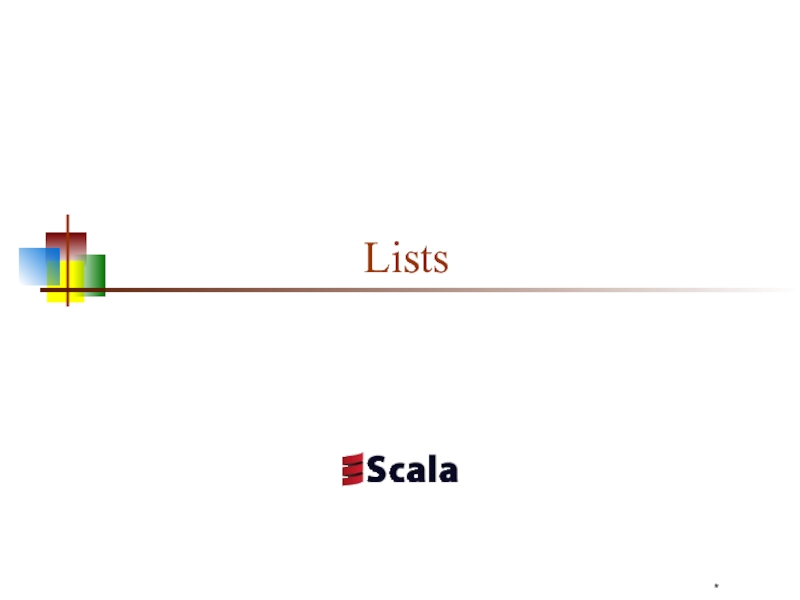
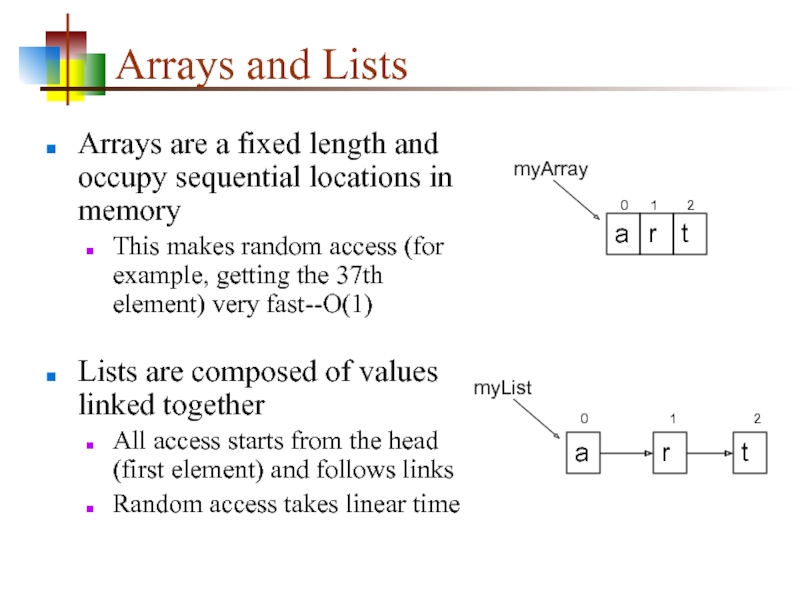

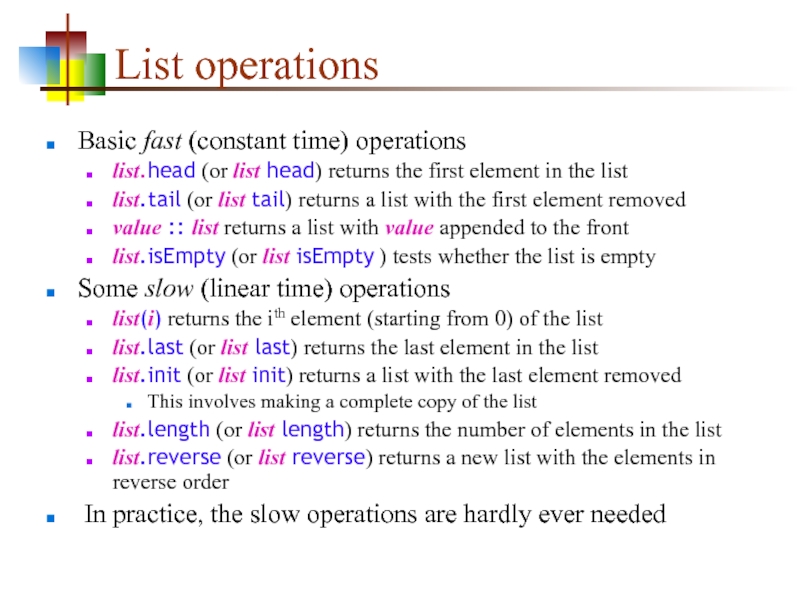
![Stepping through a listdef printList1(myList: List[Any]) { for (i](/img/tmb/3/222593/ff20196e07f153dfe0087a363850b784-800x.jpg)
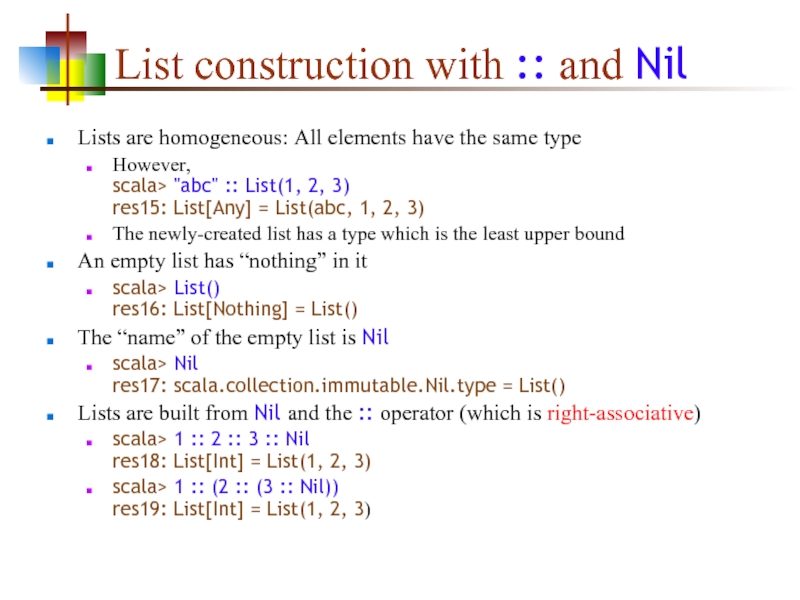
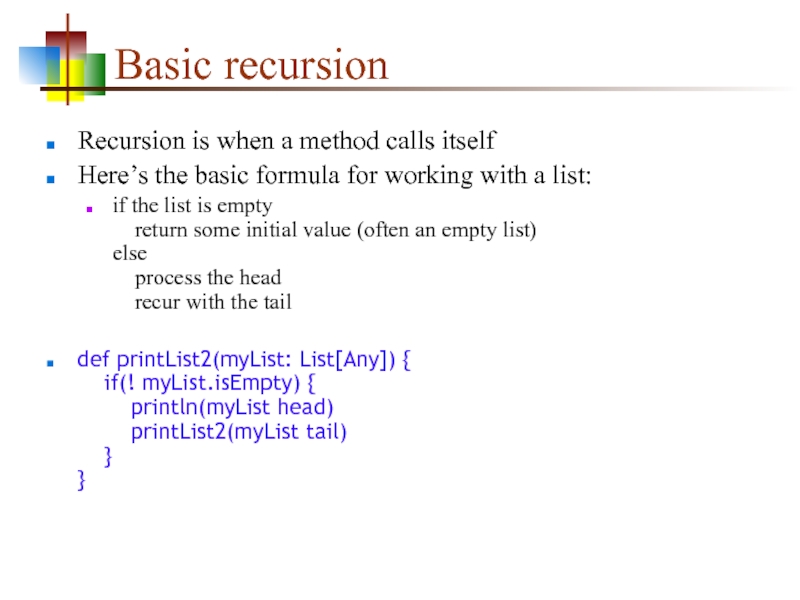
![Again, with pattern matchingHere’s our same method again:def printList2(myList: List[Any]) { if(! myList.isEmpty) {](/img/tmb/3/222593/2deaf9f76665f6b5ff0215680349aace-800x.jpg)
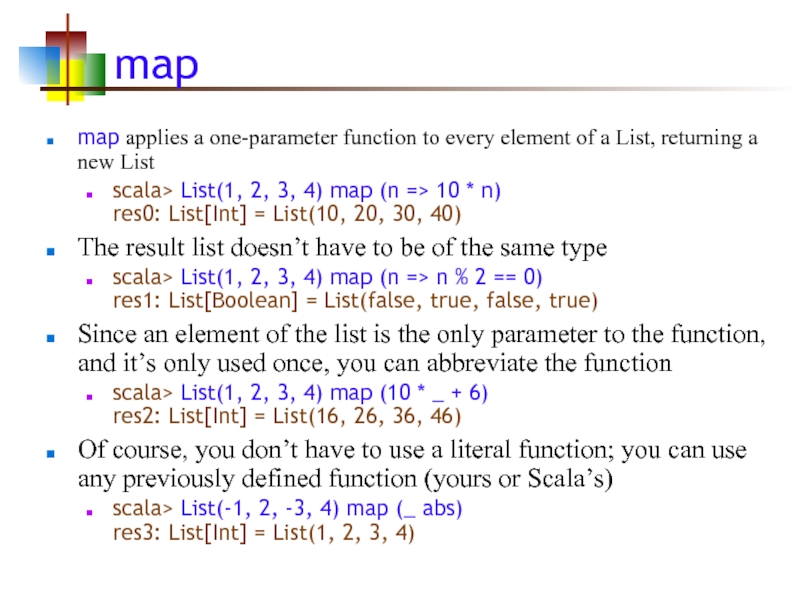
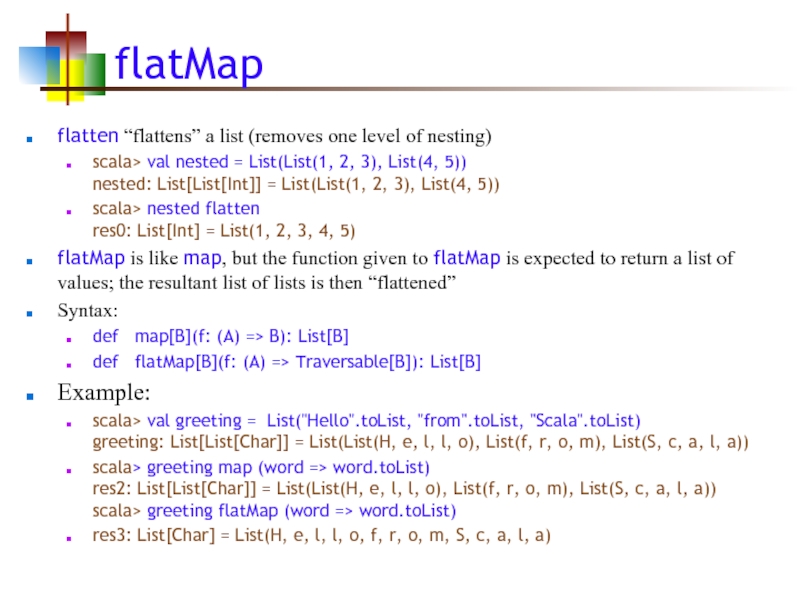
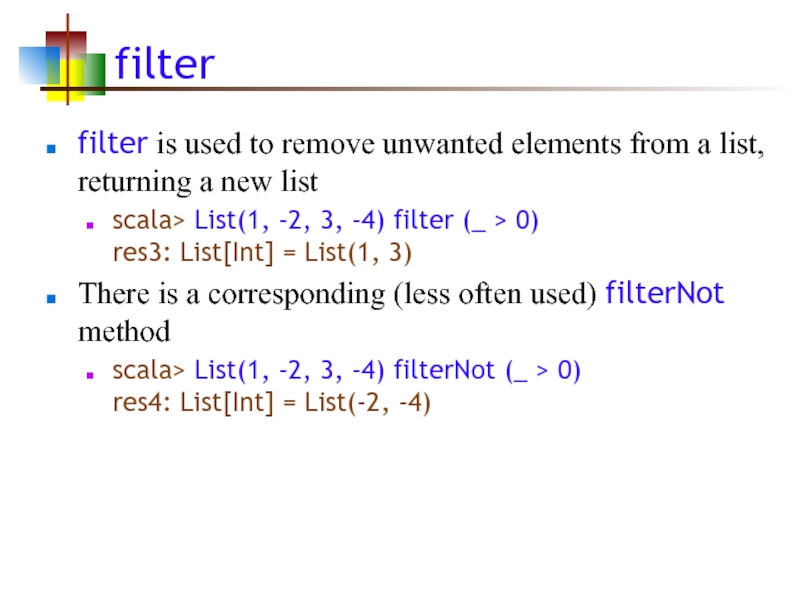
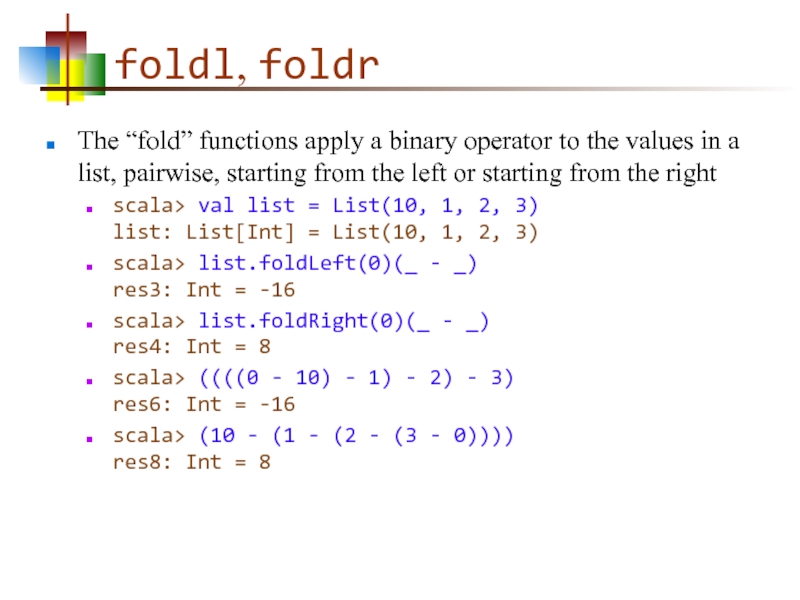
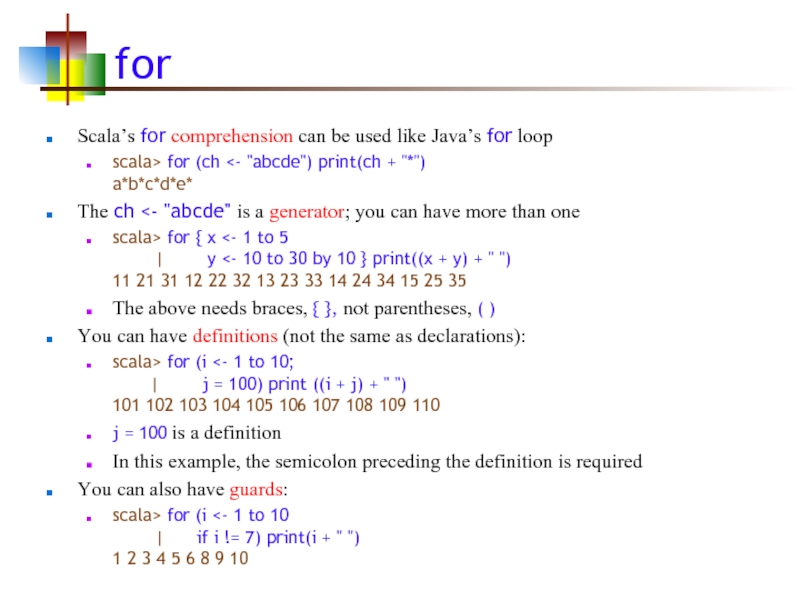


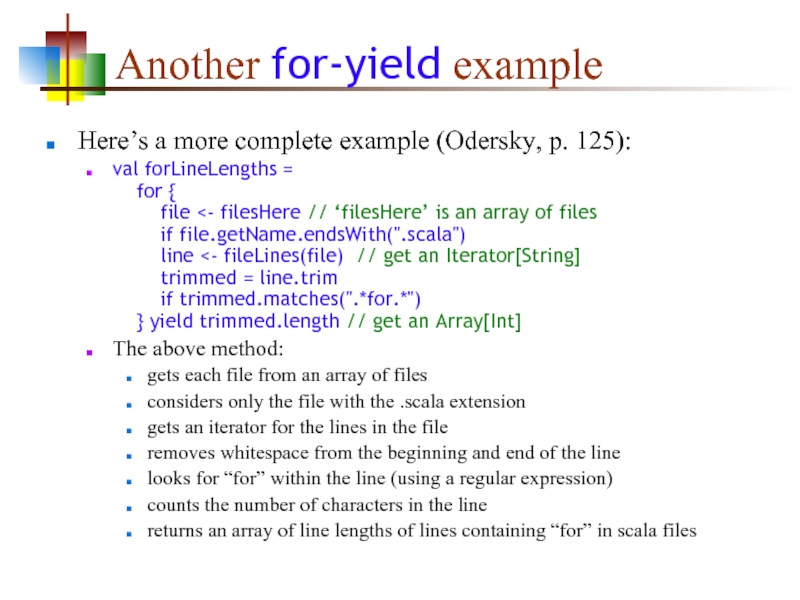
![toListscala> Array(1, 2, 3, 4) toList res12: List[Int] = List(1, 2, 3, 4)scala>](/img/tmb/3/222593/a29947507f83d70e3e4817e46ee4ab3e-800x.jpg)
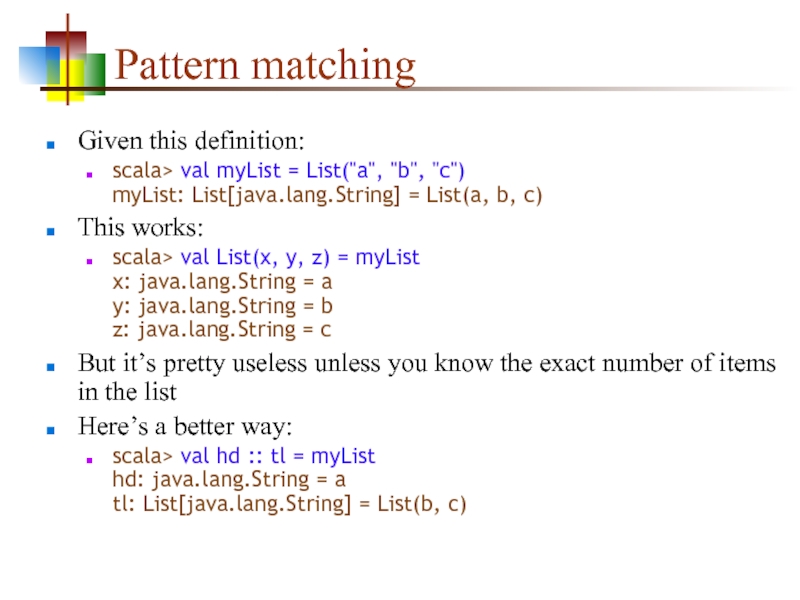
![Example programobject EnglishToGerman { def main(args: Array[String]) {](/img/tmb/3/222593/74d6d41e7b13195eb9996a9b7f1763dd-800x.jpg)
